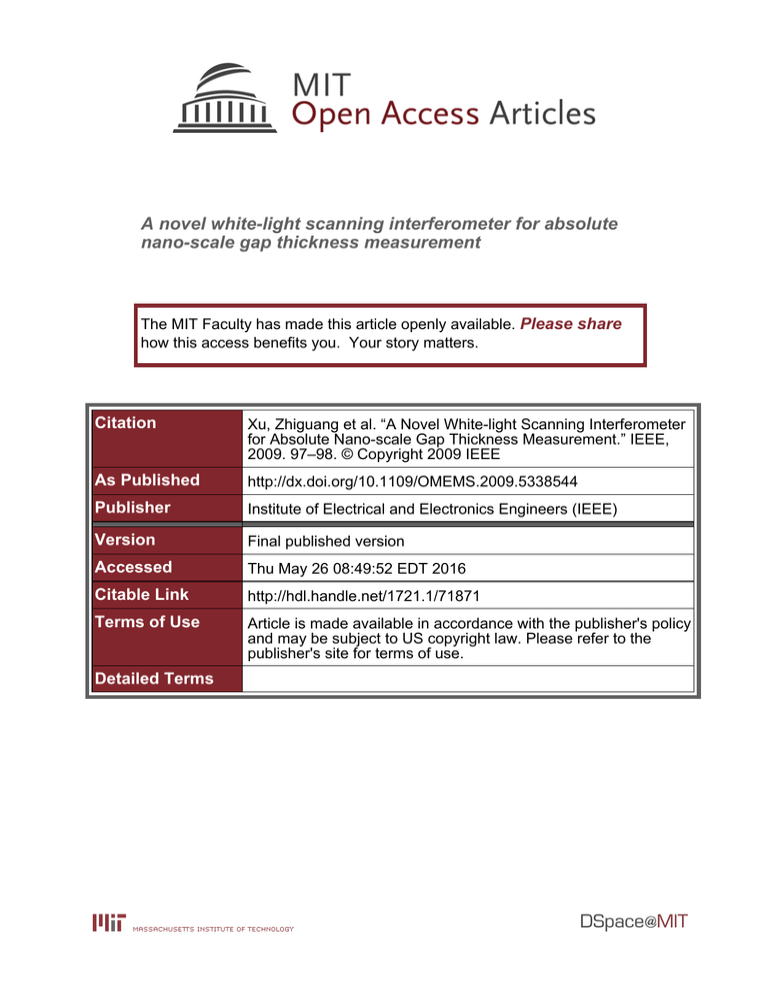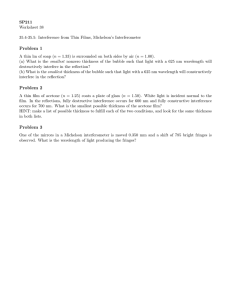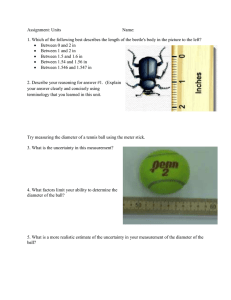A novel white-light scanning interferometer for absolute nano-scale gap thickness measurement
advertisement

A novel white-light scanning interferometer for absolute nano-scale gap thickness measurement The MIT Faculty has made this article openly available. Please share how this access benefits you. Your story matters. Citation Xu, Zhiguang et al. “A Novel White-light Scanning Interferometer for Absolute Nano-scale Gap Thickness Measurement.” IEEE, 2009. 97–98. © Copyright 2009 IEEE As Published http://dx.doi.org/10.1109/OMEMS.2009.5338544 Publisher Institute of Electrical and Electronics Engineers (IEEE) Version Final published version Accessed Thu May 26 08:49:52 EDT 2016 Citable Link http://hdl.handle.net/1721.1/71871 Terms of Use Article is made available in accordance with the publisher's policy and may be subject to US copyright law. Please refer to the publisher's site for terms of use. Detailed Terms WP2 3:30 PM – 5:30 PM A novel white-light scanning interferometer for absolute nano-scale gap thickness measurement Zhiguang Xu1, 2, 3*, Vijay Shilpiekandula1, 3, Kamal Youcef-toumi1, 3, Soon Fatt Yoon2, 3 1. 2. Massachusetts Institute of Technology, 77 Massachusetts Avenue, Cambridge, MA 02139, USA School of Electrical & Electronic Engineering, Nanyang Technology University, Singapore 639798 3. Singapore-MIT Alliance, N3.2-01-36, 65 Nanyang Drive, Singapore 637460 * Corresponding author: zgxu@mit.edu Introduction A small-scale gap included between two planar plates has found new applications in a broad range of fields in recent years. For example, the micro-scale or nano-scale gaps are precisely formed and controlled to purify the water from the process industry in environmental science, and filter the cells or molecules in biotechnology, pharmaceutical and food industries [1-3]. A 300nm gap capacitor was employed in the dielectric spectroscopy to determine the dielectric properties of genomic and proteomic structures [4]. In DNA microarrays replication technique the gap between the master and substrate needs to be strictly controlled to the order of 10 nm, to make the single-stranded DNA features perfectly duplicated [5]. Many technologies, especially optical approaches, have been developed to meet the requirement for absolute gap thickness measurement. Among these methods the optical geometry, ultrasound technique, PSD (position-sensitive detector) sensing, laser confocal sensor are limited by their micron-level resolution and accuracy. The diffraction based technique, though capable of scaling the gap as micro as near to contact, requires certain patterns to be printed on the plate forming the gap, which is not feasible for many applications. White-light interferometer has both the high resolution and high accuracy [6]; however, it cannot measure the gap formed by plates with high chromatic dispersion, unless a compensate plate, i.e. a plate with identical thickness and refractive index, is inserted into the reference arm, which makes this method not convenient in many cases. In this paper a special configuration of white-light scanning interferometer is developed, in which the measured gap is not located in any interference arm of the interferometer, but acts as an amplitude-and-phase modulator of the light source. Compared to the common white-light interferometer, our approach avoids the influence of the chromatic dispersion of the planar plates on the gap thickness measurement. It possesses a large measurement range of from several hundreds of nanometers to tens of microns as well as a high resolution of 0.1 nm, but does not employ any expensive equipment like spectrometer or monochromator. These advantages make our approach quite competent for the practical applications. Apparatus configuration The experimental setup applied in this approach is shown schematically in Fig. 1. White light emitted from a quartz halogen lamp, covering the wavelength from 400nm to 1100nm, is collected into a light guide and collimated by an aperture as well as an achromatic lens. The parallel beam, reflected by a beamsplitter, is then incident on the gap included between the two optical plates. Here, multiple-beam interference takes place, making both the amplitude and phase of the light modulated. Subsequently, the gap-modulated beam is guided into a Michelson interferometer, in which a PZT (Piezoelectric Transducer) driven mirror is placed in the moving arm and a fixed mirror in the reference arm. The reflected beams from the two arms are recombined and interference with each other, and the consequent light intensity is measured by a photodetector and recorded into the computer for further processing. Signal Simulation When the PZT drives the moving mirror, the length difference between two interference arms Δ is changed, causing the variation of the light intensity I received by the detector. Based on the theoretical analysis, the I—Δ curve is simulated and illustrated in Fig. 2, where three peaks can be observed evidently. The central upward peak occurs at the position of Δ = 0; the side burst two peaks are downward and located at Δ = h and Δ = −h, respectively. Here, h means the gap thickness. Therefore, the gap thickness can be determined by measuring the spacing between the central peak and the side two, and the chromatic dispersion of the plates including the gap has not any influence in quantifying the gap thickness. This forms the basic principle of our approach. Data Processing Signal-processing algorithms are designed for processing different gap thickness. (i) For gaps thicker than 10 μm the thickness can be easily determined by the spacing between the peaks. (ii) For gap thickness between 1μm and 10 μm, the distance between the central peak and the side two is small enough to make the side burst lobes of the peaks combined into the peak data, causing these three peaks deviate from their ideal locations. An algorithm is designed to subtract the central peak from the signal to make only the side two peaks left, and thus the gap thickness can be quantified accurately by measuring the half spacing between these two peaks. (iii) For the gap thickness less than 1 μm, even after subtracting the central peak the thickness still can not be calculated directly, because the two side peaks are close enough to make side lobes of one peak superimposed to the other. Curve matching technique by correlation calculation is applied to process this case. By computer simulation we include two side peaks and vary their spacing from 1 nm to 1 μm to obtain their corresponding curves, forming a database for gap thickness from 1 nm to 1 μm. The practically acquired signal, after subtracting the central peak, will be compared with the curves in the database by correlation calculation, and the one matching the practical signal best indicates the gap thickness. 978-1-4244-2382-8/09/$25.00 ©2009 IEEE 97 White Light Source Light guide Lens Aperture 1 0 Multi-beam Interference Fig. 2. Simulated signal received by the photodetector for a 10 μm gap. Aperture 2 Gap PZT Moving Mirror a Beamsplitter Reference Mirror Photodetector 0 Michelson Arrangement b Fig. 3. (a) Experimental curve detected by the photodetector, in which the gap thickness is determined to be 6.3732 μm. (b) Simulated theoretical curve for the 6.3732 μm gap. Fig. 1. Schematic of experimental setup to measure the gap thickness between two planar plates. Experimental Results One typical experimental signal acquired for a practical gap is shown in Fig. 3 (a), where the abscissa axis represents the PZT translation and axis of ordinates shows the intensity received by the photodetector. Based on our signal processing, the gap thickness is estimated as 6.3732 μm. In the practically acquired curve the difference between the intensity of the peak and of its side lobes appears not so significant, because the light source does not emit all the wavelengths by an even ratio; the same goes for the transmission of the applied lens and beam splitters, as well as the detection of the photodetector. Taking into account all the actual parameters of applied components in our apparatus, the theoretical curve for a 6.3732 μm gap is simulated and illustrated in Fig. 3 (b), from which we can see the match between the practical and simulated results. The short-term and long-term repeatabilities of our approach are both examined to test the precision of our approach. (i) In the first experiment the same gap with the thickness about 500 nm is measured eight times within one minute, and their thicknesses are determined as 500.3 nm, 509.2 nm, 497.5 nm, 508.4 nm, 494.0 nm, 499.2 nm, 497.5 nm, 494.4 nm, respectively. The SD (Standard Deviation) of the measurements is determined as 5.8 nm. (ii) The long-term repeatability is examined by measuring a 5.88 μm gap in one hour with the time spacing of 5 minutes. The estimated thicknesses are 5.8858 μm, 5.8910 μm, 5.9087 μm, 5.9021 μm, 5.9029 μm, 5.8782 μm, 5.8621 μm, 5.8725 μm, 5.8767 μm, 5.8663 μm, 5.8546 μm, 5.8561 μm, and 5.8492 μm. The SD is calculated to be 19.7 nm. The measurement resolution of our approach is determined by the resolution of PZT translation, which is currently 0.1 nm. The measurement range depends on the scanning length of the employed PZT; if larger range is required, an electromechanical actuator such as the voice coil motor can be selected. The high repeatability of our apparatus makes it competent for the practical applications. 1. S. E. EVLASOV, "Evaluating the quality of optical surfaces by the width of interference fringes", Meas. Tech., 12, 942-943, (1969). 2. G. W. Meindersma, C. M. Guijt, and A. B. De Haan, "Water Recycling and Desalination by Air Gap Membrane Distillation", Environ. Prog., 24, 434-44, (2005). 3. J. M. Li, C. Liu, X. D. Dai, et al. "PMMA microfluidic devices with three-dimensional features for blood cell filtration", J. Micromech. Microeng., 18, 095021, (2008). 4. Ionescu-Zanetti C, Nevill JT, Di Carlo D, et al, “Nanogap capacitors: sensitivity to sample permittivity changes,” J. Appl. Phys., 99, 24305, (2006). 5. Yu AA, Savas TA, Taylor GS, et al, “Supramolecular nanostamping: Using DNA as movable type,” Nano Lett., 5, 1061-1064, (2005). 6. Alain Courteville, Rainer Wilhelm, and Fabrice Garcia, "A novel, low coherence fibre optic interferometer for position and thickness measurements with unattained accuracy", Proc. of SPIE, 6189, 618918, (2006). 98





